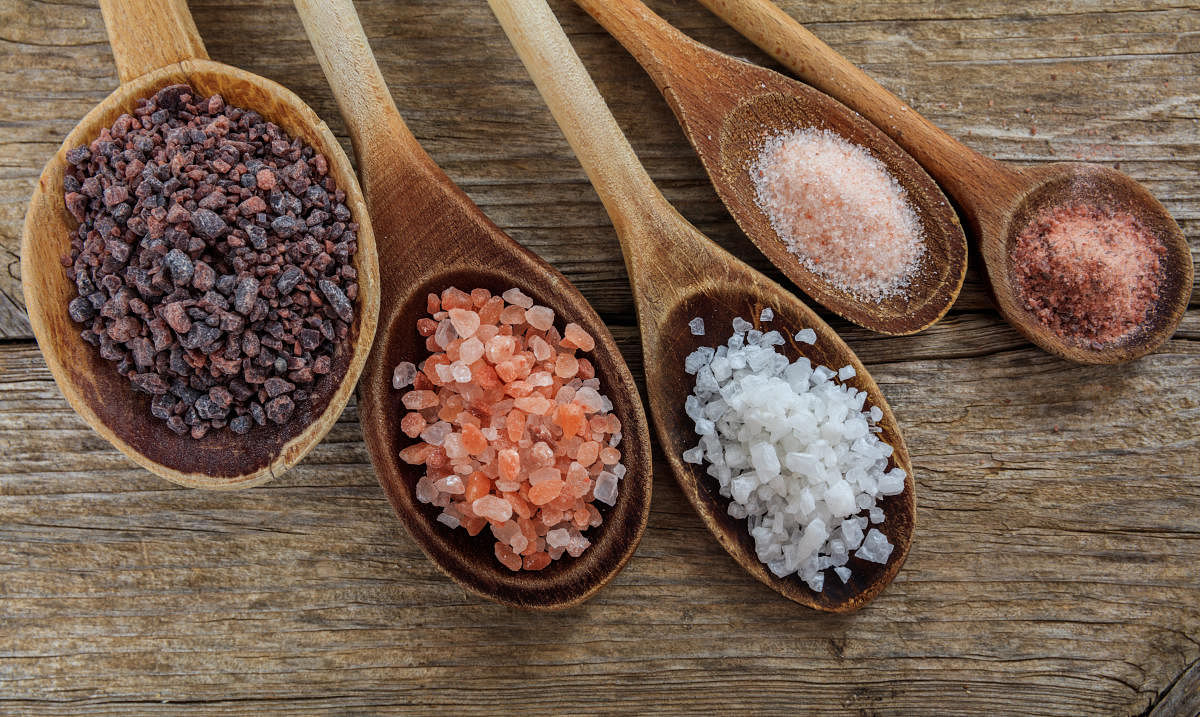
In a dark sooty hut at Kalleshwara near Ramanguli in the Western Ghats, we watched Vanita, Ganga, and Vasanthi prepare unusual dishes of the Siddi community. Siddis are descendants of African slaves employed as guards by the Portuguese and Indian royalty who eventually dispersed around Gujarat, Maharashtra and Karnataka. They have a forest-based cuisine dominated by fiddlehead ferns, colocasia leaves, rice flatbreads, and fish. In their remote kitchen we learnt a key principle of cooking — don’t overdo the fish. All you need for a delicious Mahli Bachhi is a sprinkle of Sanikatta salt on the fish, grilled directly on glowing embers.
The fawn-hued Sanikatta salt is no ordinary salt. Sourced from the 581-acre saltpans near Gokarna, it is the secret ingredient in Uttara Kannada/North Canara cuisine, essential in local fish and curry preparations. Arun Nadkarni, chairman of the Nagarbail Salt Owners Cooperative Society explained how the salt-making tradition has continued unbroken for 300 years. After meandering through the densely forested Western Ghats, the mineral-rich waters of the Gangavalli and Aghanashini rivers are chanelled into large basins resembling giant waffles and sundried to make salt in the brackish backwater region. Water from enclosed seas and lakes evaporates to leave behind isometric crystals rich in sedimentary minerals called sendha namak or rock salt. These underground mineral deposits can run hundreds of metres deep; untouched and pristine, it is widely consumed during religious fasting. Rich in trace minerals, it has cooling properties with several medicinal benefits.
Little wonder that a harsh tax levied by the British on an essential commodity like salt launched a revolution — Gandhiji’s Salt Satyagraha or Dandi March. Salt is ingrained in our culture as the first item served at a traditional meal and a symbol of loyalty illustrated in the phrase ‘Humne aapka namak khaya hai’ meaning ‘I have partaken your salt’. It was so precious that in ancient Rome, soldiers’ wages were paid in salt; the word ‘salary’ originates from salarium or ‘salt money’. A capable person was considered ‘worth his salt’. The Roman practice of salting leafy greens gave the term ‘salad’. Thanks to salt trade, the early roads and cities developed.
In the pink...
Himalayan pink salt (coloured by mineral impurities) is equally prized in culinary circles, spa treatments or as therapeutic lamps. Apparently, Alexander’s army first stumbled upon it on their Himalayan passage to India.
In Ladakh, Changpa tribesmen harvested salt from high altitude saline lakes like Tso Mo Riri, Tso Kar and Pangong Tso and traded it along with Pashmina wool in the Tibetan highlands.
Eons ago, the Indian Ocean or Lavan Sagar (Sea of Salt) covered much of the desert tract of Western India. Gujarat, home to one of the world’s largest salt deserts — the Rann of Kutch, accounts for nearly 80% of India’s salt production. In mountainous Arunachal Pradesh, the Apatani tribe evolved an ingenious way of manufacturing salt. Maize or lai leaves are charred to ashes, mixed with water, evaporated, the residue wrapped in leaf, and smoked over a wood fire. The result is a natural dark vegetarian salt called tapiyo, believed to be the secret of their health.
Much cherished
Be it Salar de Uyuni in Bolivia, Pammukale in Turkey, the Dead Sea in Israel/Jordan or the Danakil Depression in Ethiopia, salt is more than a commodity, it is a spectacle.
Peru’s ancient salineras (salt mines) of Maras in the Sacred Valley date back to Incan times and are still in use. Salty spring water channelled into a tapestry of terraced pools evaporates, leaving sediments that are harvested, a technique that’s lasted for 2,000 years. In Mauritius, where the economy and culture were shaped by sugar, salt is equally cherished.
Fleur de sel, literally ‘Flower of Salt’, is hailed as the Queen of Salts championed by chefs and gourmands alike. Formed as a thin, delicate crust on evaporating seawater, it is renowned for its characteristic crunch and clean light taste. At Melbourne’s Queen Vic Market, the fourth-gen run Gewurzhaus stocks single origin salts and exotic blends like Tahitian Vanilla Salt, French Lavender Salt to Black Lava Sea Salt…
In Poland, Wieliczka’s Kopalnia Soli is one of the world’s oldest operational salt mines and perhaps the oldest corporation dating back 800 years. A subterranean tour down a wooden staircase leads to shafts and komoras (excavated chambers).
After the wooden church burnt down in an accident, miners began carving statues, panels, and chandeliers out of rock salt, thus unfolding a jaw-dropping legacy of saline architecture, the highlight being a stunning chapel.
The tour ends with a meal in an underground restaurant with salt memorabilia on sale like lamps, bracelets, decorative items, and everything from table salt, smelling salt to bath salt crystals.
(The authors are travel and food writers “loosely based” in Bengaluru. They’ve authored guides and coffee table books including a cookbook for the USDA called ‘Southern Comfort: Southern American Soul Food’, set up an award-winning restaurant, and curated the India episode of Gordon Ramsay: Uncharted, Season 2. Follow their adventures on Instagram: @red_scarab)